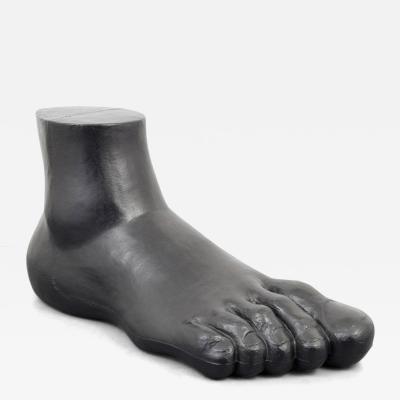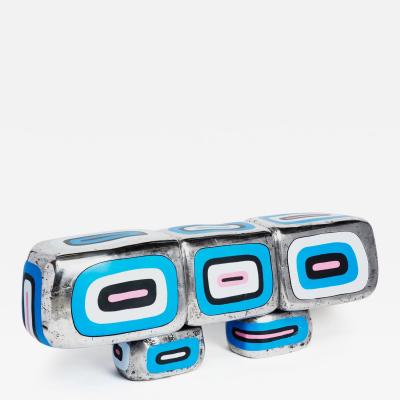How Gaetano Pesce Uses Resin to Turn Graffiti Art into Design
 |
Gaetano Pesce Show Reveals The Designer's Eccentric Genius
Galerie56, 56 Leonard Street, Tribeca, New York through May 8
Monday through Friday, 10am–6pm
By Benjamin Genocchio Photos by Olympia Shannon
Gaetano Pesce “Unframed” at Galerie56, the cultural space founded by architect Lee F. Mindel, located in Tribeca at 56 Leonard Street is an irregular show, consisting almost entirely of Pesce’s drawings rather than realized objects, quite unusual for a design show. But then, Pesce is an irregular, eccentric, original figure. The 83-year-old Italian designer and architect lives in New York where he continues to create colorful, resin-based designs which he refers to as "mass-produced originals."
Pesce was one of the first designers to work exclusively in colored resin and has made it his signature material. Resin poured into a mold or hand-spun into spaghetti-like strands allows his designs to be replicated in ways so that each piece will be just that little bit different. He is an artist foremost, interested in design as an act of creation, but also in creating products we can use in our daily lives. He is a conundrum, in short.
 |
Pesce is extremely interesting as a creative mind, even if not all of his designs strike a chord. For his current show, he set several requirements for Mindel, who is a long-time fan and supporter of the designer. “He insisted that drawings on paper all be installed on the walls without frames, covered in acetate paper and then taped to the wall with strips of thick black gaffer tape,” Mindel says. “Hence the show title.”
Opened last October, Mindel’s Galerie56 has a mission to present advanced design shows to the New York art and design community. The space is nested in the ground floor, street-level space of 56 Leonard Street, a residential building designed by architects Herzog & De Meuron and flanked by a new landmark sculpture by Anish Kapoor, a giant metallic ball that appears to have been squashed by the building.
 |  |
It is most unusual to see large, thick welts of black tape framing drawings on walls, but what else would one expect from Pesce? He designed his own show invitations, made of resin, of course, which the gallery was obliged to purchase from the designer for $50 each in order to send out. Mindel didn’t mind all of these antics because, he says, “with Gaetano and his work you are kind of either all in or out.”
 |
Pesce is having something of a resurgence in the design world. Through March 31 he is presenting “Dear Future,” an exhibition at The Future Perfect's Beverly Hills gallery location the 1916 Arthur S. Heineman-designed Goldwyn House, formerly owned by film mogul Samual Goldwyn. The exhibition showcases Pesce's early designs for brands including B&B Italia alongside contemporary creations.
 |
Pesce has always kept an eye on the future as a designer, or more accurately has spent a career characterized by a restless dissatisfaction with the present moment in time and devoted himself to trying to imagine what the future might look like. Mindel astutely grasped this and the present show presents 60 fascinating drawings that relate both to realized architecture and interior projects, as well as unrealized ideas and spaces, reflecting, Mindel explains, “the artist’s unbounded imagination.”
The human face, often in silhouette, and body are constant reference points for the designer and appear in several of his works here, such as humanoid cabinets and felt chairs as well as resin wall sculptures of his abstracted profile. Even his architecture (or at least drawings of it) can appear to be “figurative” as in concept drawings on view of important projects such as the Bahia House and Maison des Enfants.
 |
 |
I hesitate to call Pesce a humanist but there is a strong humanism to his work. Over and above that, there is just this fantastical dimension to so much of what he draws, with imagery of imaginary structures filled with gardens, sculpture and monuments. Pesce’s drawings are pure imagination, unencumbered for the most part by practical considerations as to their actual feasibility. This is conceptual design, raw ideas in action that hint at possibilities for the future, even if unattainable right now.
Another key element in his work is playfulness. “His concept of the world and sense of materiality is uniquely characterized by a profound sense of humor,” Mindel says. This is evident in a smaller selection of Pesce’s designs in resin on display, such as the bookcase titled “Self-portrait model,” a large “Fish Coffee Table” and most famously “UP 7 (II Piede),” a unique prototype of a giant red foot that has become something of a signature piece.
 |
There is so much to think about here, and so much pleasure as well — two qualities often lacking in contemporary design. Trust Pesce, a sort of graffiti artist in resin, a shaman of day-glow sculpture, to remind us of what really matters in art and life.































